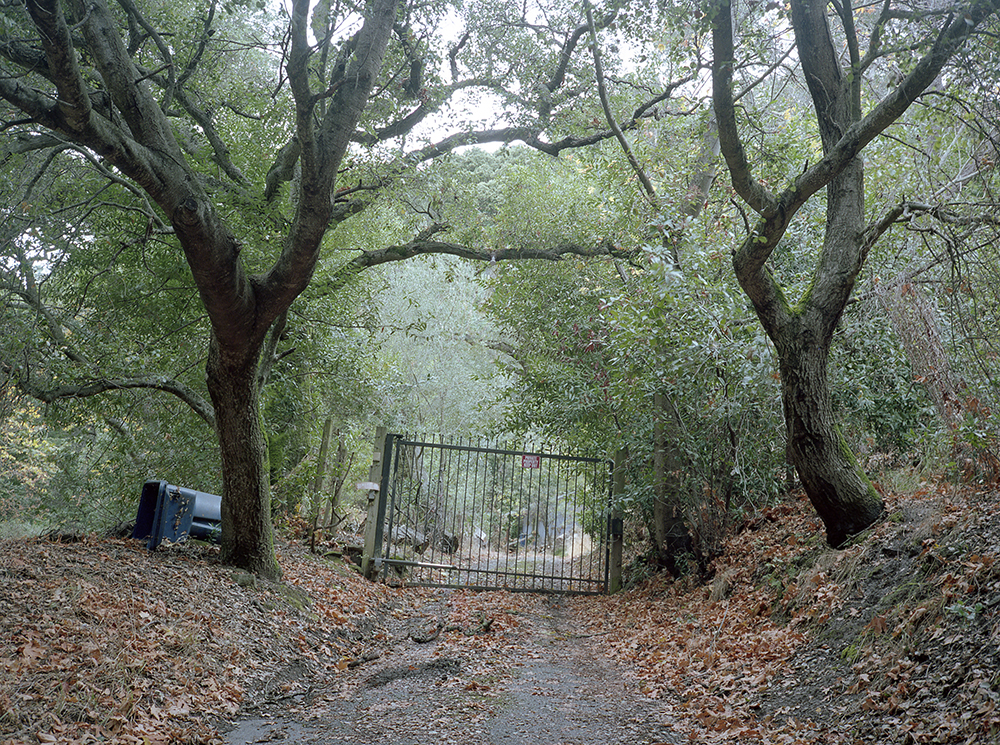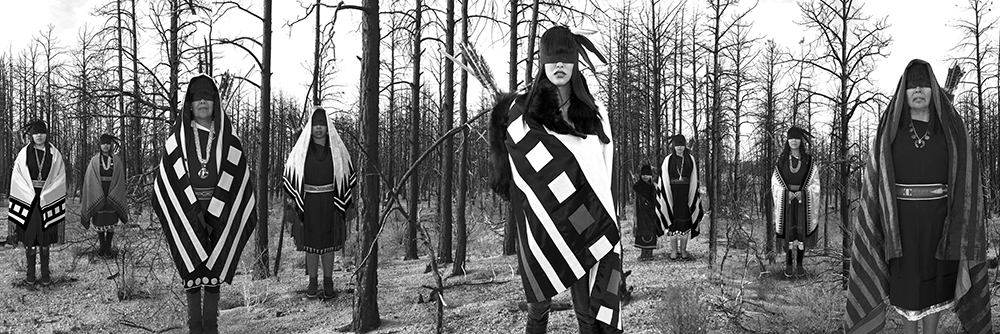Native American Heritage Week: Interview with Casey Riley/ In Our Hands: Native Photography, 1890 to Now

Larry McNeil Dakl’aweidi K’eet Gooshi H’it, Killer Whale Fin House Tlingit / Nisga’a, born 1955 Herbert Johnson, Man of the Bear Clan, 2018 Palladium print Courtesy of the artist © Larry McNeil, All Rights Reserved
Today we finish our two-part feature on In Our Hands: Native Photography, 1890 to Now , the exhibition currently on view at the Minneapolis Institute of Art (Mia). Presented in Mia’s 12,000 square foot Target Gallery, the exhibition is comprised of three thematic sections. By intermingling works created across time and place, and works that vary in format and formal approach, each section reveals the breadth and depth of Native photographic practice over that last 130 years, and carries forward Mia’s commitment to presenting work by Native American artists.
In addition to the thematic galleries, the exhibition includes reflection spaces for both Native and non-Native visitors, providing room for contemplation of the works on view. Key terms and phrases will also be identified and discussed throughout the show to ensure knowledge-sharing within and beyond Native audiences. As an overview of the exhibition development process, biographical information of curatorial and community council members is also included.
“I truly believe that it is important for the legacy of all photographers to know this history, and it is the history of the land you are more than likely standing upon,” said Jaida Grey Eagle, consulting curator. “This history and the stories told by the photographers are incredible testaments to the original people of this land. I hope that our collective journeys allow the next Indigenous youth who says they want to be a photographer to be believed wholeheartedly by their family, community, and all of us. It is a beautiful life, and we will be waiting for you with open arms and hearts.”
Curatorial Council
- Rhéanne Chartrand (Métis), curator, McMaster Museum of Art, University of Toronto
- Mique’l Icesis Dangeli (Tsimshian), adjunct professor, University of Northern British Columbia
- Rosalie Favell (Metis), artist
- Tom Jones (Ho-Chunk), associate professor, University of Wisconsin–Madison
- Amy Lonetree (Ho-Chunk), associate professor, University of California, Santa Cruz
- Shelley Niro (Mohawk), filmmaker and artist
- Veronica Passalacqua, curator, C.N. Gorman Museum, University of California, Davis
- Jami Powell (Osage), curator of Indigenous art, Hood Museum of Art, Dartmouth College
- Jolene Rickard (Tuscarora), associate professor, Cornell University
- Cara Romero (Chemehuevi), artist
- Hulleah Tsinhnahjinnie (Seminole/Muscogee/Diné), professor and curator, University of California, Davis
- Emily Voelker, assistant professor, University of North Carolina at Greensboro
- Laura Wexler, professor, Yale University
- Will Wilson (Diné), artist, photographer, and chair of the photography department at Santa Fe Community College
Community Council
This council serves as advisors and consultants to the exhibition as it is presented in Minneapolis.
- Alexandra Buffalohead (Bdewakantowan Dakota), artist, curator, musician, and arts and cultural engagement manager at the Native American Community Development Institute and All My Relations Arts Gallery in Minneapolis, Minnesota
- Sharon Day (Bois Forte), Ojibwe leader and Native American activist, artist and writer
- Coral Gessner (Choctaw, Chickasaw, African American, Polish, English, Irish, Scottish), Equity, Inclusion, and Anti-racism Coordinator for Saint Paul Public Library
- Raphael Gonzales, a Dakota/Boricua hip hop artist and activist from Minneapolis, Minnesota
- Heidi Inman (Sisseton Wahpeton Sioux Tribe), an artist, photojournalist, and environmental activist
- Delaney Keshena (Menominee), moccasin maker and fine artist
- Bazille Owen-Reese, a beadworker from the Ho-Chunk Nation of Wisconsin
- Iyekiyapiwin Darlene St. Clair (Lower Sioux Dakota Oyate), Multicultural Resource Center director and associate professor at St. Cloud State university
- Maryam Marne Zafar (Lenape/African American/
I sat down with curator Casey Riley to discuss what this exhibition achieves and what was the approach in putting the show together.

©Louis Situwuka Shotridge, Stoowukháa (Astute Man) Kaagwaantaan clan Tlingit, 1883-1937 A Git-Keen young man, Skeena River, Sept 26, 1918, 1918 University of Pennsylvania Museum, 14938
In curating this exhibition, what was the approach and why was it critical to create an arc narrative that spans decades?
Casey Riley: “In Our Hands” approached the work of the exhibition and publication collaboratively; from the earliest days of the project, we were in conversation with leading voices in the fields of Native art and photography. Those conversations led to the formation of our Curatorial Council, with whom we met [virtually] to develop the goals, major themes, and checklist for the show. The historical scope of the project was vital to the Curatorial Council; everyone felt strongly about acknowledging the vast achievements of past generations of Indigenous artists who had shaped the course of the medium. Their work provides crucial context for the activities of contemporary Indigenous photographers, and the conversation across the decades is visible in the works selected for the show.

Kalen Goodluck Diné (Navajo) / Mandan / Hidatsa / Tsimshian, born 1993 (Chap-pah-sim, Co-to-plan-e-nee, I-o-no-hum-ne, Sage-womnee, Su-ca-ah and We-chilla. The land was seized by unratified treaty in 1851 and granted to Alabama for the benefit of Auburn University), 2020 from Land-Grab Universities series Courtesy of the artist © Kalen Goodluck
What are some memorable things that have happened while organizing the exhibition?
Casey Riley: I can’t speak for the group, but for me the conversations with our Curatorial Council were among the most illuminating and memorable elements of this project. It was an incredible privilege to be in dialogue with the folks on our council—most of them have dedicated their lives to the work of Native photographers, or are themselves artists, and they were endlessly generous with their time and guidance. It is humbling and necessary to recognize the work that we need to do in museums to center the achievements of Native photographers; what I learned from the Council is that the work is also enormously exciting and rewarding, not least because of the vitality of the artworks involved.

Horace Poolaw Kiowa, 1906-1984 Horace Poolaw aerial photographer, and Gus Palmer (Kiowa), side gunner inside a B-17 Flying Fortress, Tampa, Fla., c. 1944 Courtesy of the Poolaw Family and the Nash Library, University of Science and Arts of Oklahoma
What do you feel this exhibition has achieved in terms of elevating Indigenous art, artists and issues?
Casey Riley: It was important for us to include the work of younger or emerging artists in the show, even as we sought to champion the work of established artists. There are so many outstanding photographers rising in the field, and we recognized the ways in which a project like this one can elevate one’s profile. More than anything, we hope that many opportunities will result from “In Our Hands,” and that the artists in the show will benefit from the exposure. We were overjoyed to welcome artists from many generations to the opening, and to see them in conversation with one another; those relationships are as important as any other outcome of the show, in my mind.

©Horace Poolaw Kiowa, 1906-1984 Eula Mae Narcomey Doonkeen (Seminole) in the American Indian Exposition Parade, 1952 Courtesy of the Poolaw Family and the Nash Library, University of Science and Arts of Oklahoma

©Dorothy Chocolate Carseen Tłı̨chǫ, born 1959 Judith Charlo carrying a hide, T’èɂehdaà (Dettah) NWT, 1988 NWT Archives/Northwest Territories. Department of Public Works and Services fonds/G-1995-001: 2774

©B.A. (Benjamin Alfred) Haldane Tsimshian, 1874-1941 Benjamin A. Haldane self-portrait in studio in Metlakatla, c. 1919- 1920 11 x 14 in. Image Courtesy of Ketchikan Museums: Photograph by Benjamin A. Haldane, KM 89.2.14.21

Cara Romero Chemehuevi, born 1977 TV Indians, 2017 Archival inkjet print Courtesy of the artist © Cara Romero

Virgil Ortiz Cochiti Pueblo, born 1969 Tahu, and her Army of Blind Archers, 2013 Inkjet print Courtesy of the artist © Virgil Ortiz
Casey Riley oversees Mia’s department of Global Contemporary Art and the research, exhibition, and publication of the museum’s renowned collection of art after 1970. Her curatorial practices are rooted in collaboration and informed by the principles of inclusion and equity. Recent projects at Mia include “Objectivity: Metaphorical and Material Lives of Photographs,” “Dayanita Singh: Pothi Khana,” “Hindsight: American Documentary Photography 1930-1950,” “Vision 2020: Jess Dugan,” “Just Kids,” and “Strong Women, Full of Love: The Photography of Meadow Muska.” In partnership with Mia colleagues and a curatorial council of fourteen artists, scholars, and knowledge sharers, she is co-organizing a survey of works by First Nations, Metis, Inuit, and Native American photographic artists, opening at Mia in October 2023.
Riley was the assistant curator at the Boston Athenaeum and consulting curator at the Isabella Stewart Gardner Museum. She has published widely on American art and photographic history, and has most recently co-organized, with Frank Goodyear and Lisa Hostetler, “Marcia Resnick: As It Is, Or Could Be,” the catalogue for which received the Photography Network Book Prize. An experienced educator, Riley is a graduate of Yale University, holds master’s degrees from Brown University and Middlebury College, and earned her PhD from Boston University. She is a member of the 2023 class of fellows at the Center for Curatorial Leadership in New York City.
Instagram: @see.riley
Jill Ahlberg Yohe, PhD, is Mia’s associate curator of Native American Art. She has curated and co-curated numerous exhibitions, including “Hearts of Our People: Native Women Artists” with Teri Greeves (Kiowa) in 2019; “In Our Hands: Native Photographers 1890–Now” with Jaida Grey Eagle (Lakota) and Casey Riley, opening at Mia in fall 2023; and upcoming exhibitions of overlooked women artists: avant-garde Santa Clara potter Jody Folwell in 2024 and Dakota artist Mary Sully in 2025.
Since coming to Mia in 2014, Ahlberg Yohe has expanded its collection of Native American art with more than 100 contemporary artworks and major historic works from across Native North America. Her reinstallations of Mia’s Native American art galleries, organized with former fellows Dakota Hoska (Lakota) and Juan Lucero (Isleta Pueblo), have brought Native perspectives to bear on the museum’s collection, including innovative interpretations by artists and scholars Roy Boney (Cherokee) and Candessa Tehee (Cherokee), Andrea Carlson (Ojibwe), Alex Buffalohead (Dakota), and Josephine Hoffman (Anishinaabe).
Over the last decade, she has co-edited three major publications and written extensively on Navajo weaving, Native art theory and practice, and contemporary Native art. In seeking new initiatives and collaborations, Ahlberg Yohe aims to expand understanding and advance curatorial practices around historical and contemporary Native art.
Jaida Grey Eagle is an Oglala Lakota artist, born in Pine Ridge, South Dakota, and raised in Minneapolis. Jaida is a photographer, producer, beadwork artist, writer, and aspiring curator. She graduated from the Institute of American Indian Arts with her Bachelors in Fine Art emphasizing in fine art photography. She works with Casey Riley, Chair of Global Contemporary Art and Curator of Photography and New Media, and Jill Ahlberg Yohe, Associate Curator of Native American Art, and focuses on events and art that center indigenous identity, language, and culture. Click here to see more of Jaida Grey Eagle’s work.
Instagram @jaida.greyeagle
In Our Hands: Native Photography, 1890 to Now
Enter into the vivid worlds of Native photography, as framed by generations of First Nations, Métis, Inuit, and Native American photographers themselves. Presenting over 150 photographs of, by, and for Indigenous people, “In Our Hands” welcomes all to see through the lens held by Native photographers.
Organized by a council of primarily Native artists, scholars, and knowledge sharers, in partnership with Mia curators, this sweeping exhibition traces the intersecting histories of photography and diverse Indigenous cultures from the Rio Grande to the Arctic Circle. Beautiful, complex, and surprising, these artworks celebrate the legacy of groundbreaking photographers and their influence on the medium today.
Instagram: @artsmia
Posts on Lenscratch may not be reproduced without the permission of the Lenscratch staff and the photographer.
Recommended
-
Dawn Roe: Super|NaturalJanuary 4th, 2026
-
Time Travelers: Photographs from the Gayle Greenhill Collection at MOMADecember 28th, 2025
-
Arnold Newman Prize: C. Rose Smith: Scenes of Self: Redressing PatriarchyNovember 24th, 2025
-
The Aline Smithson Next Generation Award: Emilene OrozcoNovember 21st, 2025














































